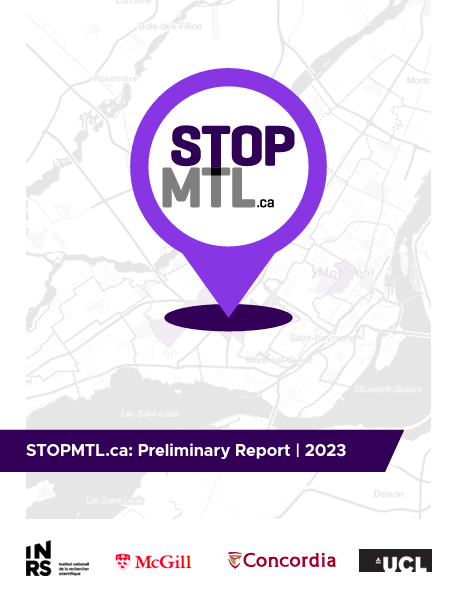STOPMTL.ca: Preliminary report, 2023

Côté-Lussier, C., Bradford, B., Carmichael, J., Cloutier, M.-S., Kakimani, L., Kapo, L. T., & Lashley, M. (2023, mai)
Centre Urbanisation Culture Société | 28 p.
The stopmtl.ca project uses a participatory mapping methodology to allow individuals to self-report their police stop experiences in the city of Montreal, Canada. Between July 14th 2021 and December 21st 2021, a total of 714 police stop experiences were contributed to the stopmtl.ca website. Of these contributions, approximately 28% (N = 197) were removed due to a programming error that led to the duplication of cases. Of the remaining contributions (N = 517), 21% were suspected fake data and 7% were excluded due to missing data. A total of 369 contributed police stop experiences were retained (71%). A descriptive analysis of the data suggests that most police stop experiences were reported by men (74%), individuals who identified as being White (55%), hetereosexual (70%) and being aged between 19 and 24 years (27%). A Black racioethnic identity was the second most frequent racioethnic identity (17%). In terms of spatial distribution, stop experiences were reported as occurring most frequently in the Côte-des-Neiges (13%) and Ville-Marie (12%) boroughs of Montreal. Nearly half of all reported stops were reported as having occurred in 2021 (49%), and most frequently in the summer months (May-August) (65%), peaking in July (33%). The most frequent activity individuals reported doing during their stop was being in a vehicle (42%), followed by walking (23%). Respondents could identify multiple reasons for which they believed they were stopped. The perceived reason for the stop most frequently identified was what the person was doing (39%), followed by their appearance (30%). Roughly equal proportions of police stops were seen as justified (41%) and as not justified (43%). There are several similarities between the characteristics of self-reported police stop experiences contributed to stopmtl.ca and police-recorded stops in the city of Montreal, Canada. Namely, there appears to be a comparable spatial distribution of police stops in both data sets, as well as some indication of a comparable social distribution (e.g., gender, age and racioethnic identities of those stopped). However, the self-reported police stop data is limited in several important ways. Namely, for self-reported police stops with available data on whether the respondent received a sanction following their stop (i.e., fine, arrest or charge) (N = 129), 42% were said to have led to a sanction. This limits the capacity to draw strong comparisons between self-reported data and police-recorded data (which excludes all stops leading to a sanction). Though criteria were applied to exclude suspected fake data, it is not possible to establish the veracity of self-reported stops. Nevertheless, these preliminary descriptive results provide a snapshot of who self-reported their stops and of the types of stops that led to self-reports. Furthermore, the data provide insight into citizens’ perceptions of their police stop experiences. Future directions for research, including planned validation analyses and a second wave of data collection are discussed.
